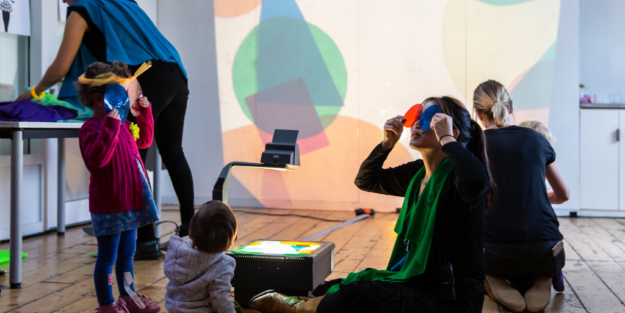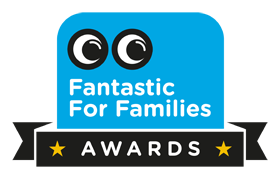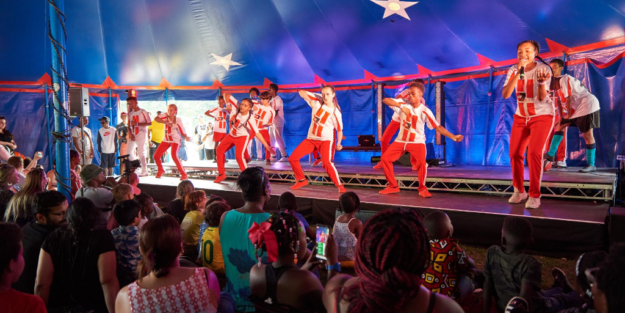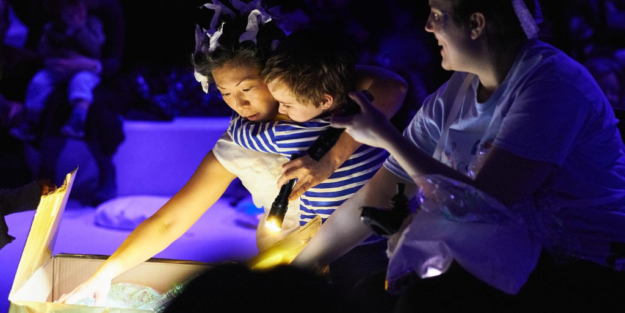Fantastic for Families Award 2020 Case Study
Liat Rosenthal:
Developing family content as an independent producer
Bauhaus Baby Ballroom was a collaboration between Liat & Co and London’s Whitechapel Gallery. The event was one of the winners of the 2020 Best Famliy Event Award. Here we spoke to the event’s producer, Liat Rosenthal, who shares learnings and insights gained from developing family content as an independent producer.
What is the ‘Bauhaus Baby Ballroom’?
The Bauhaus Baby Ballroom aimed to celebrate 100 Years of the Bauhaus with families at the Whitechapel Gallery. We created an event bursting with form, function and fun – translating key ideas and works from this iconic artistic movement into accessible and playful activities that could be enjoyed by all. Imagine an arts extravaganza meeting a family disco. We marked 100 years of Bauhaus with music, art, dancing, making and mayhem. From geometric mobiles, architectural collage, to abstract costume creation and bauhaus badges. And importantly, mocktails – serving up a Walter Gropius Glass or a Kandinsky Mix.
How did it start?
The story of the ‘Bauhaus Baby Ballroom’ started in 2016, after the birth of my daughter, Zelda. I was adjusting to life as a new mother when we heard of David Bowie’s passing. Saddened by the loss of this legendary icon, I was on the hunt for an event that celebrated his life and legacy – and there were many. However, none were family friendly, yet alone baby-friendly. So, I created ‘Bowie Baby Ballroom’ for family audiences, co-produced with the Arcola, in East London. It was a flamboyant, and rather moving, marking of Bowie’s work, fit for families. We created a space where families could connect, hit the dance floor, indulge in ziggy stardust face painting, and craft space spiders from mars. It was evident that families were seeking cultural programming directly inspired by art and artists, enabling both adults and children to learn, engage and enjoy. It was from this point that the vehicle of the ‘Baby Ballroom’ was established, as a method of marking key cultural moments, made accessible for family audiences. The Bauhaus Baby Ballroom took the opportunity to bring the eclectic mix of programme content together to celebrate 100 years of Bauhaus, as I felt there was a need to find ‘ways into’ the subject for families.


Collaborating with Whitechapel Gallery
Working as an independent creative producer, it’s essential to partner with the right venue and find venue programmers/ curators that value the collaborative process. The proposed family event needs to be a strong fit for the venue’s audience, and their wider programming strategy, but it also needs to be exciting enough to take a step into the unknown. I found that the collaboration with the Whitechapel Gallery families curator, Helen Davison, was strong because we worked to develop the content ideas together. Helen offered so many insights into how families engaged with the gallery, how they accessed the programme, when and how they’d book, details on visitor flow within the building. The generosity of knowledge was also matched by a generosity of resources; crafts, bits of set dressing, AV, staffing. It was a genuine partnership with learning gained on both sides.
My Top Tips
- Make the building work for family audiences – this is not always easy as most buildings are not designed for hundreds of little people to attend at any point, and this is further amplified if your event is aimed for the very young. Think carefully about temporary buggy parks, additional changing areas and extra staffing available to offer a helping hand.
- The Value of Quiet Spaces– and can be very easy to implement. Family events tend to be busy and noisy, so creating a space for calm is always warmly received. It can be as simple as offering an additional room so parents can have a break, or breastfeed, for little ones to have some tummy time and for older children that are seeking a quiet space as well as those who are sensitive to sensory overload. Gentle music usually can help set the tone for calmer space.
- Pick ‘n’ Mix programming – it’s important to think about different age groups and interests, so as much as it’s great to have a wide variety of activities for children (music, crafts, make-up, free play etc). It’s also important to have activities that might be of interests to adults – for example a (very) short curatorial talk, or a quiz with grown-up prizes, interesting facts about the subject covered etc.
- Info Info Info – some visitors, especially those heading to a cultural event with their baby for the first time, like to know what to expect. It’s very reassuring for families to find a ‘frequently asked questions’ section on the website event page. Details such as easy routes to the venue, quiet spaces, catering onsite or nearby, baby change facilities and how you monitor sound levels are all good to include. Venues usually have this on their website, but it’s always extra useful to consolidate this with the event info for easy access.
Image credits: Rob Harris and Michiyo Yanagihara
4 September 2020
FURTHER INFORMATION

Liat Rosenthal is a Creative Producer specialising in widening participation to the arts. She is currently Senior Creative Producer for Tate Modern’s Uniqlo Tate Lates, alongside working on a portfolio of events, projects and consultancies. liatandco.com





